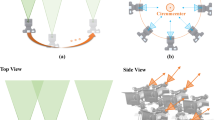Abstract
In this paper, we present an effective disparity mapping method for binocular stereoscopic image. It is inspired by the observation that its displayed depth would change, when a stereoscopic image is displayed on different size screens. The phenomenon may bring an uncomfortable experience for viewers. To make a comfortable stereoscopic image for viewers, moreover to adapt a stereoscopic image to a target display screen, we propose a content-aware disparity adjustment method. Firstly, the disparity mapping is established to control and retarget the depth of a stereoscopic scene. Then, the relationship between the disparity editing and image content editing is established to guide the proposed warping model. At last, to implement the disparity mapping operator, we propose a content-aware stereoscopic mesh warping model, which can simultaneously avoid the salient region distortion and adjust disparity to a target range by establishing the relationship. Experimental results show that the proposed method can effectively adjust disparity of stereoscopic image, which not only avoids the salient region distortion and adjusts disparity to a target range.






Similar content being viewed by others
References
Basha T, Moses Y, Avidan S (2013) Stereo seam carving a geometrically consistent approach. IEEE Trans Pattern Anal Mach Intell 35(10):2513–2525
Chan HM, Chung ACS, Yu SCH, Wells WM (2004) III 2D–3D vascular registration between digital subtraction angiographic (DSA) and magnetic resonance angiographic (MRA) images. IEEE Biomed Imaging Nano Macro 1:708–711
Chang CH, Liang CK, Chuang YY (2011) Content-aware display adaptation and interactive editing for stereoscopic images. IEEE Trans Multimedia 13(4):589–601
Feldmann I, Scheer O, Kauff P (2003) Nonlinear depth scaling for immersive video applications. WIAMIS, London
Fröhlich B, Barrass S, Zehner B, Plate J, Gobel M (1999) Exploring geo-scientific data in virtual environments. Proc IEEE Vis 99:169–173
Getty DJ, D’Orsi CJ, Pickett RM (2008) Stereoscopic digital mammography: Improved accuracy of lesion detection in breast cancer screening. Lect Notes Comput Sci 5116:74–79
Goferman S, Zelnik-Manor L, Tal A (2012) Context-aware saliency detection. IEEE Trans Pattern Anal Mach Intell 34(10):1915–1926
Halbfinger DM (2008) [Retrieved March 13]; with theaters barely digital, studios push 3-D. New York Times, New York
Heckbert PS (1989) Fundamentals of texture mapping and image warping. Master’s thesis, University of California, Berkeley
Hirschmuller H (2008) Stereo processing by semiglobal matching and mutual information. IEEE Trans Pattern Anal Mach Intell 30(2):328–341
Hoffman DM, Girshick AR, Akeley K, Banks MS (2008) Vergence-accommodation conflicts hinder visual performance and cause visual fatigue. J Vis 8(3):33, 1–30
Holliman N (2002) 3D display systems. Department of Computer Science, University Durham, Durham, Technical Report
Jiang GY, Zhou JM, Yu M, Zhang Y, Shao F, Peng ZJ (2014) Binocular vision based objective quality assessment method for stereoscopic images. Multimedia Tools Appl. doi:10.1007/s11042-014-2051-x
Jung C, Wang S (2014) Visual comfort assessment in stereoscopic 3D images using salient object disparity. Electron Lett 51(6):482–484
Kang K, Cao Y, Zhang J, Wang ZF (2014) Salient object detection and classification for stereoscopic images. Multimedia Tools Appl. doi:10.1007/s11042-014-2142-8
Lang M, Hornung A, Wang O, Poulakos S, Smolic A, Gross M (2010) Nonlinear disparity mapping for stereoscopic 3d. ACM Trans Graph 29(4):1–10
Lin H, Guan S, Lee C, Ouhyoung M (2011) Stereoscopic 3D experience optimization using cropping and warping. In: ACM SIGGRAPH Asia Sketches. Hong Kong. doi:10.1145/2077378.2077428
Liu F, Gleicher M, Jin H, Agarwala A (2009) Content-preserving warps for 3d video stabilization. ACM Trans Graph 28(3):36–44
Liu F, Niu Y, Jin H (2013) Casual stereoscopic photo authoring. IEEE Trans Multimedia 15(1):129–140
Luo SJ, Shen I, Chen BY, Cheng WH, Chuang YY (2012) Perspective-aware warping for seamless stereoscopic image cloning. ACM Trans Graph 31(6):182–190
Shibata, T., Kim, J., Hoffman, D.M. & Banks, M.S. (2011) The zone of comfort: Predicting visual discomfort with stereo displays. J Vis 11(8):11, 1–29
Smolic A, Kauff P, Knorr S, Hornung A (2011) Kunter: three-dimensional video postproduction and processing. Proc IEEE 99(4):607–625
Wang L, Jin H, Yang R and Gong M (2008) Stereoscopic in painting: joint color and depth completion from stereo images. In: Proceedings of IEEE conference on computer vision and pattern recognition (CVPR). pp 1–8
Wang YS, Tai CL, Sorkine O, Lee TY (2008) Optimized scale-and-stretch for image resizing. ACM Trans Graph 27(5):1–8
Yoo JW, Yea S, Park IK (2013) Content-driven retargeting of stereoscopic images. IEEE Signal Process Lett 20(5):519–522
Zitnick CL, Kang SB, Uyttendaele M, Winder S, Szeliski R (2004) High-quality video view interpolation using a layered representation. ACM Trans Graph 23(3):600–608
Acknowledgments
This work is supported by the National Natural Science Foundation of China under Grants 61471262, by Natural Science Foundation key international (regional) cooperation research projects 61520106002, and by Ph.D. Programs Foundation of Ministry of Education of China under Grants 20130032110010, by China Scholarship Council (CSC).
Author information
Authors and Affiliations
Corresponding author
Rights and permissions
About this article
Cite this article
Yan, W., Hou, C., Wang, B. et al. Content-aware disparity adjustment for different stereo displays. Multimed Tools Appl 76, 10465–10479 (2017). https://doi.org/10.1007/s11042-016-3442-y
Received:
Revised:
Accepted:
Published:
Issue Date:
DOI: https://doi.org/10.1007/s11042-016-3442-y




